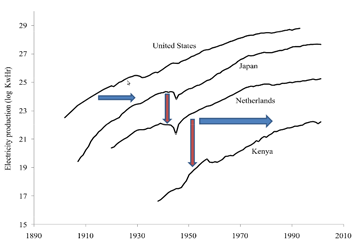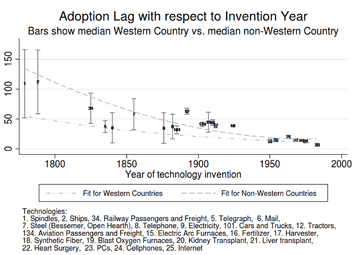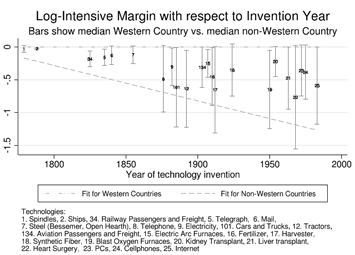Cross-country inequality is persistent. This column draws on economic history to explain the mechanisms by which dramatic cross-country differences in income emerge. We can reduce inequality through policies that facilitate the penetration of new technologies in poor and middle-income countries. Such policies can go a long way towards reducing existing cross-country income disparities.
Two-hundred years ago, cross-country differences in income were relatively small. European countries and Western offshoots, what Maddison (2004) called Western countries, were on average 90% richer than the rest (Note 1). By 2000, this income gap had grown to 750%. Most economic studies of long-run development have tried to relate current income differences to pre-determined factors, such as genetic endowments, cultural differences, climate and institutions (e.g., Spolaore and Wacziarg 2009; Ashraf and Galor 2013; Acemoglu et al. 2005; Guiso, Sapienza and Zingales 2003). Typically, these studies regress current income per capita on the proposed pre-determined drivers, finding high correlations. However, these exercises are not very informative about the mechanisms by which the dramatic cross-country differences in income have emerged or about the timing of the divergence.
Recent research
In our recent paper (Comin and Mestieri 2013) we tackle the following two questions:
- What accounts for the bulk of growth dynamics over the long term?
- Why do these drivers differ across countries?
We approach these questions by investigating whether the cross-country evolution of direct measures of technology can induce income dynamics similar to those observed in the data.
The contribution of technology to a country's productivity growth can be decomposed in two parts. One part is related to the range of technologies used, or equivalently to the lag with which they are adopted. New technologies embody higher productivity. Therefore, an acceleration in the rate at which new technologies arrive in the country raises aggregate productivity growth. Productivity is also affected by the penetration rate of new technologies. The more units of any new technology (relative to income) a country uses, the higher the number of workers or units of capital that can benefit from the productivity gains brought by the new technology. Thus, increases in the penetration rate of technology (or as we call it below, the intensive margin of adoption) also raise the growth rate of productivity.
Comin and Hobijn (2010) showed that the diffusion curves for different countries have similar shapes, but displaced vertically and horizontally (Figure 1). This regularity implies that the relative position of a curve can be characterised by only two parameters. The horizontal shifter informs us about when the technology was introduced in the country. The vertical shifter captures the penetration rate the technology will attain when it has fully diffused.
 [ Click to enlarge ]
[ Click to enlarge ] Using the CHAT data set (Comin and Hobijn 2009), we identify the extensive and intensive adoption margins for 25 significant technologies invented over the last 200 years in an (unbalanced) sample that covers 132 countries. Then, we use our estimates to study the cross-country evolution of these two adoption margins. We uncover two new empirical patterns:
- Cross-country differences in adoption lags have narrowed over the last 200 years (Figure 2).
That is, adoption lags have declined more in poor/slow adopter countries than in rich/fast adopter countries.
- Second, the gap in penetration rates between rich and poor countries has widened over the last 200 years, inducing a divergence in the intensive margin of technology adoption (Figure 3).
 [ Click to enlarge ]
[ Click to enlarge ]  [ Click to enlarge ]
[ Click to enlarge ] After characterising the dynamics of technology, we explore their consequences for the cross-country dynamics of income. In particular, we simulate the dynamics of income in two representative economies (one 'developed' and one 'developing'). After feeding in the dynamics of technology adoption we have uncovered in the data, the model generates cross-country patterns of income growth that resemble very much those observed in the data over the last two centuries. In particular, in developed economies, it took approximately one century to reach the modern long-run growth rate of productivity (2%) while in developing economies it takes twice as much, if not more. As a result, the model generates a 3.2-fold increase in the income gap between rich and developing countries, which represents 80% of the actual fourth-fold increase observed over the last two centuries (Table 1).
 [ Click to enlarge ]
[ Click to enlarge ] To obtain a better understanding of the forces at work, we sequentially shut down the two adoption margins. This exercise yields two main findings:
- The large cross-country differences in adoption lags explain much of the income divergence during the nineteenth century between Western countries and the rest of the world;
- The Great Divergence continued during the 20th century because of the divergence in penetration rates (i.e., intensive margin of adoption) between Western countries and the rest of the world.
The model also does well in reproducing the income gap between rich and developing countries circa 1820, and the observed growth dynamics for the countries in the bottom quarter and tenth of the world income distribution, and for the different continents (Note 2). Hence, this shows that adoption dynamics are at the core of the Great Divergence that has taken place over the last two centuries.
Concluding remarks
Our paper does not take a stand on what forces drive adoption lags and the intensive margin. However, they suggest that policies directed towards facilitating the penetration of new technologies in poor and middle-income countries can go a long way towards reducing the existing cross-country income disparities.
This article first appeared on www.VoxEU.org on May 28, 2013. Reproduced with permission.



